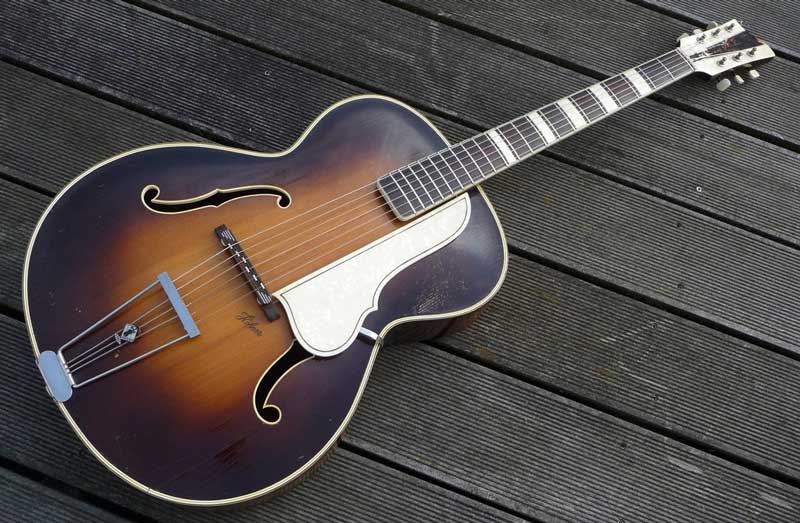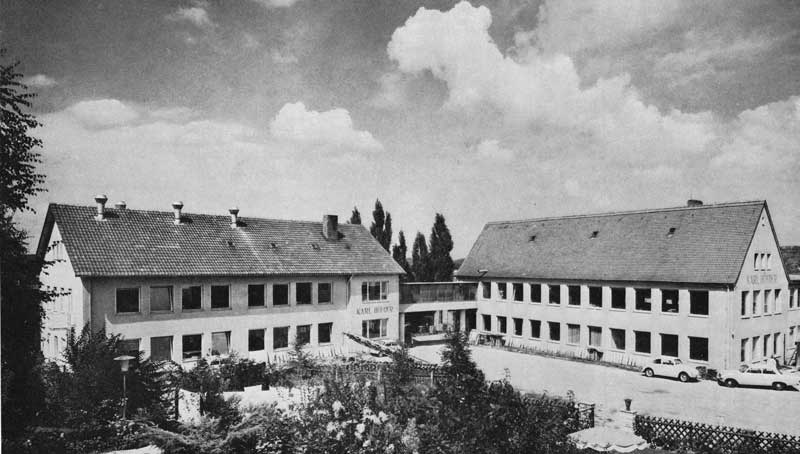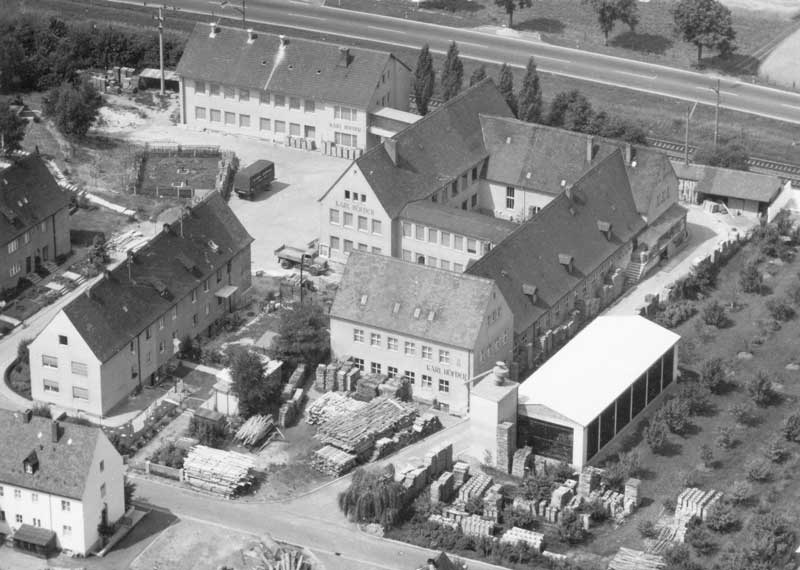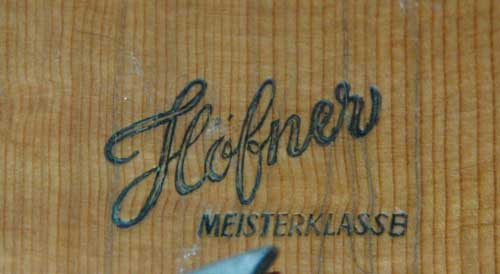
c1952 Hӧfner 457 Archtop Guitar
Josef and Walter Hӧfner had
achieved a remarkable turn-around in their fortunes. Their eighteen-page
catalogue of 1950 had increased to fifty seven pages by the following year and
whilst Walter was getting on with the practicalities
of setting up the manufacturing facility that was necessary to produce such an
impressive range of products, his brother Josef was busy renewing all his old
overseas contacts that had been so important to the Company before the war.
The biggest hurdle to such
growth however was the lack of suitable sized workshop and office premises. The
old barrack buildings at Mӧhrendorf were just not adequate in either size or
layout. Worse still, the inhabitants of Mӧhrendorf were becoming increasingly
agitated about the large influx of refugees from Schönbach that had been
attracted to their area once news got around that the old
Hӧfner Company was rising again from the ashes. This should not have come as any
surprise as Walter was already highly respected for his running of Hӧfner in
Schönbach during the 1920s and 30s. So,….what was to be done?
As well as developing the vital
export market, Josef Hӧfner also found the time to sort out the above problem.
Being highly astute and something of a diplomat, he struck up contacts with the
local dignitaries, in particular Herr Willi Hӧnekopp who was the County
Administrator and the politician most responsible for establishing the Bubenreth
luthiers’ settlement. Joseph asked for his help in finding a permanent home for
his company and also for the Schönbach luthiers. Very soon, in July 1949 he was
invited to attend the local council meeting at Bubenreuth, which is just three
kilometres from Mӧhrendorf. At that meeting, he explained to the people
of that town just how important it was for the luthiers and the Company to find a new
home, and he also presumably stressed the advantages to the existing community
of having a world-wide exporter such as Hӧfner on their doorstep. Whatever he actually
did say certainly worked, with the council there and then declaring
that “We want to help these people”. Hӧfner had found their new home.
Land was allocated very quickly
at the edge of Bubenreth for the new Hӧfner
workshops as well as good quality housing for their refugee workforce. Grants
were obtained to help finance all this, and by the end of 1949 the first
residents were moving into their new houses. A year later at Christmas 1951, the
first Bubenreuth offices and workshops were completed, and so production moved
from Mӧhrendorf to Bubenreuth at the end of 1951. Josef and Walter each took one
of the newly-built houses. These just happened to be the two closest to the
Workshops, on opposite sides of the appropriately named Schӧnbacher Strasse.
They lived in those homes for the remainder of their lives, with a larger
detached house being later built in the 1960s directly adjacent to and
overlooking the Workshops for Walter’s daughter Gerhilde and her husband Christian
Benker, who in the future were to take up the running of the Company for many successful
years.


Walter of course had been busy
in the meantime. New guitar models were necessary in order to keep abreast of
the demands of Josef's new customers. In 1952, almost as a celebration of the move to Bubenreuth, Hӧfner’s most loved
and debatably best “players” archtop appeared; the 457 model, pictured at the
top of this page. This was the
guitar without the glitz but with an in-built quality of design and
construction. It was a 16¼” full-bodied archtop with basically the same
specification as the earlier 456 model but with (initially) a solid carved
spruce top and beautiful flamed maple back and rims. A five-piece
spruce/mahogany neck with good quality rosewood fingerboard was fitted, and
suitably modest binding and purfling was provided to body sides, sound-holes,
and neck. For the first year, the body had no cutaway, but this was available as
an option from 1953, together with factory-fitted electrics. Just like Ford’s
Model T, it was initially available in any colour, providing that finish was brown
lacquer!
Three other models also appeared
at the same time as the 457 in 1952 - the 459, the 461, and the 462. After the
rock-solid conservatism of the 457 model, Walter seems to have decided to have
some fun with these new models.
The 459 used the basic 456/457 formula, but...it did have a birds eye maple back, serious-looking black binding, and those sickle-shaped soundholes instead of the conventional F-holes. On the plus side, most of the 459 examples made were finished in clear blonde lacquer which of course showed-off the birds eyes nicely, and it also had a solid carved spruce top. A twin arm tailpiece, similar to those fitted to some of Epiphone's archtops, was fitted.
The general impression given by the above two models is
one of Teutonic eccentricity rather than Kalamazoo class. As an aside, the
photos taken at the 1952 Dusseldorf Trade show shows the 459 with a small oval
soundhole adjacent to the neck in addition to the two sickles, similar to that
on the 461 described below. That feature was however very soon dropped,
certainly by the time that the catalogue photos had been taken.
The 459, 461, and the 462
had that boldness, quirkiness, and “joie de vie” that only seems to have been
re-captured by Hӧfner in 2012 with the introduction of their “Gold Label” range.
Walter Hӧfner was now in his
stride, and it would seem that he was determined to set up a range of
full-bodied archtops that would suit all tastes and (more importantly) pockets.
This he actually achieved in the fourteen year period between 1948 and 1961, with only
a few replacement full-bodied models being produced
by him after 1961. The models described in this chapter, and the end of the last
chapter, therefore can be considered to be Hӧfner’s definitive archtops, which
of course are the most numerous and also probably the most well-known.
Also introduced in 1953 were
the 464 and 468 models. These were obviously intended to cater for the upper-end
of the market.
The 464 was a feast for the eyes, with its deep gloss red finish, heavy purfling work around body edges and neck, and brilliant white pearloid headstock complete with plastic treble clef sat inside a black diamond-shaped inlay. Most striking however were the soundholes – twin sickles plus a diamond-shaped hole just below the end of the neck and bridged by yet another plastic treble clef. The guitar’s timbers were however conventional with initially a carved solid spruce body, and flame maple back and rims. A body cutaway was standard together with a top quality “Escutcheon” tailpiece, otherwise this guitar could really have been considered to be just a tarted-up 457 model. Handling a 464 is somehow different though, as it gives the impression of being a light, delicate, and strangely beautiful guitar rather than something to gig with every night in a steamy jazz club, for which the 457 would have been ideal.
So,
on to 1954 with Walter having filled in most of the gaps in his archtop range.
Just two remained, one of which was practical and the other aesthetic:
There was by now obviously a demand for large 17”+ bodied archtops in addition to the “standard” 16¼” body width. The large 468 was obviously way out of the reach of most musicians’ budgets, and so the 4550 archtop was a necessity. This was quite simply a Hӧfner 455 but with the wider body. Like the 455, it had a laminated maple top with modestly flamed laminated maple for the back and rims. Decoration such as body and neck binding, strip fret -markers, etc were however similar to the 456.
The two brothers’ father, Karl
Höfner, still remained as the elderly statesman within the company. By 1954, he
had reached the age of 90, and yet he still loved noting better than to attend
at his workbench every day. This grand old man of Bohemian and Bavarian
instrument making passed away just prior to his ninety-first birthday.
Initially, Hӧfner
archtops did not have the Hӧfner logo on their headstocks. In those less
commercial days, apparently all that was considered necessary, and tasteful
perhaps, was to have a small discrete logo somewhere on the body.

Up to around 1956, the logo was stamped into the
body top just below the treble side of the bridge. Up to around 1953 on the
high-end guitars such as the 468, the word “Meisterklasse” was also usually
stamped directly below the logo in order to assure the owner that he was playing
one of Hӧfner’s finest. Occasionally on the black lacquered guitars on which a
stamped-in logo cannot be seen, a gold decal (transfer) logo was applied either
adjacent to the bridge or on the upper bass-bout.
From 1956 onward, the gold decal logo found its way onto the upper bass bout of most of the lower-priced guitars, and also on some of the higher-end instruments. This practice was discontinued during the early 1960s, being replaced by headstock logos.
Guitars with the bell-flower headstock
inlays such as the 465 and 468 received an inlaid capital-letter Hӧfner logo on
their headstocks from around 1957/58.
_________________________________________________
All Text is Copyright
© 2022 Steve Russell. All Rights Reserved